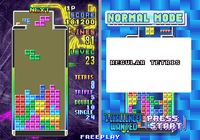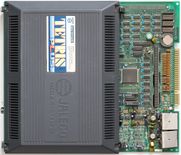Tetris Plus: Difference between revisions
No edit summary |
|||
| (9 intermediate revisions by 3 users not shown) | |||
| Line 2: | Line 2: | ||
|developer = Jaleco Inc. | |developer = Jaleco Inc. | ||
|publisher = Jaleco Inc. | |publisher = Jaleco Inc. | ||
|released = '''Arcade:'''{{release|JP|December | |released = '''Arcade:'''{{release|JP|December 1995}}'''Game Boy:'''{{release|JP|27 December 1996}}{{release|NA|August 1997}}'''PlayStation:'''{{release|JP|6 September 1996}}{{release|NA|18 November 1996}}{{release|UK|October 1997}}'''Saturn:'''{{release|JP|30 August 1996}}{{release|NA|1996?}} | ||
|platform = Arcade, Game Boy, PlayStation, Sega Saturn | |platform = Arcade, Game Boy, PlayStation, Sega Saturn | ||
|boxart = Tetris_Plus_(PlayStation,_NA)_front_cover.jpg | |boxart = Tetris_Plus_(PlayStation,_NA)_front_cover.jpg | ||
| Line 14: | Line 14: | ||
|sequel = ''[[Tetris Plus 2]]'' | |sequel = ''[[Tetris Plus 2]]'' | ||
}} | }} | ||
{{nihongo foot|'''''Tetris Plus'''''|テトリスプラス|''Tetorisu Purasu''||lead=yes|group=lower-alpha}} is a Tetris variant produced by Jaleco in 1995 for their ''Jaleco Mega System 32'' arcade hardware. In 1996 | {{nihongo foot|'''''Tetris Plus'''''|テトリスプラス|''Tetorisu Purasu''||lead=yes|group=lower-alpha}} is a Tetris variant produced by Jaleco in 1995 for their ''Jaleco Mega System 32'' arcade hardware. In 1996 ports were released for the Sega Saturn and PlayStation, as well as a Game Boy version. The game includes two single player modes, Normal Mode and Puzzle Mode, as well as a two player VS Mode which plays like a competitive version of Puzzle Mode. A sequel, ''[[Tetris Plus 2]]'', was released in 1997. | ||
On November 1st, [[2019 in Tetris|2019]], it was re-released on the [[AtGames]] Legends Ultimate Arcade. | On November 1st, [[2019 in Tetris|2019]], it was re-released on the [[AtGames]] Legends Ultimate Arcade. | ||
| Line 22: | Line 22: | ||
[[Image:TetrisPlus_02.png|200px|thumb|right|Normal mode screenshot]] | [[Image:TetrisPlus_02.png|200px|thumb|right|Normal mode screenshot]] | ||
This mode is described in the selection menu as "Regular Tetris", and plays similar to SEGA's [[Sega | This mode is described in the selection menu as "Regular Tetris", and plays similar to SEGA's [[Tetris (Sega)|1988 version]], with a speed curve which rises and falls. | ||
To either side of the playfield is a pair of bars which slowly rise with the passage of time; clearing lines will fill the bars more rapidly. When the bars are completely full, the next tetromino locked will advance the player a level and empty the bars. | To either side of the playfield is a pair of bars which slowly rise with the passage of time; clearing lines will fill the bars more rapidly. When the bars are completely full, the next tetromino locked will advance the player a level and empty the bars. | ||
| Line 105: | Line 105: | ||
=== Vs. mode === | === Vs. mode === | ||
{ | ==== Two-player layouts ==== | ||
The two-player mode cycles 10 playfield layouts at the start of a game. The cycle resets when the machine is rebooted. professor's spawn location) | |||
{| | |||
|- valign="top" | |||
|<playfield> | |||
.......... | |||
.......... | |||
.......... | |||
.......... | |||
.......... | |||
.......... | |||
.......... | |||
.......... | |||
.......... | |||
.......... | |||
.......... | |||
....XX.... | |||
....XX.... | |||
Z.L.O.S.I. | |||
.L.O.S.I.J | |||
</playfield> | |||
Playfield 1,<br>which is the Arcade<br>power-on state | |||
|<playfield> | |||
.......... | |||
.......... | |||
.......... | |||
.......... | |||
.......... | |||
.......... | |||
.......... | |||
.......... | |||
.......... | |||
.......... | |||
.......... | |||
....XX.... | |||
..T.XX.T.. | |||
.T.TTTT.T. | |||
T...TT...T | |||
</playfield> | |||
Playfield 2 | |||
|<playfield> | |||
.......... | |||
.......... | |||
.......... | |||
.......... | |||
.......... | |||
.......... | |||
.......... | |||
.......... | |||
.......... | |||
.......... | |||
....XX.... | |||
....XX.... | |||
....II.... | |||
..JJ..JJ.. | |||
TT..TT..TT | |||
</playfield> | |||
Playfield 3 | |||
|<playfield> | |||
.......... | |||
.......... | |||
.......... | |||
.......... | |||
.......... | |||
.......... | |||
.......... | |||
.......... | |||
.......... | |||
....XX.... | |||
....XX.... | |||
..GGGGGG.. | |||
.GG.GG.GG. | |||
.GGGGGGGG. | |||
..G.GG.G.. | |||
</playfield> | |||
Playfield 4 | |||
|<playfield> | |||
.......... | |||
.......... | |||
.......... | |||
.......... | |||
.......... | |||
.......... | |||
.......... | |||
.......... | |||
.......... | |||
.......... | |||
.......... | |||
....XX.... | |||
ZZZ.XX.JJJ | |||
Z.Z.GG.J.J | |||
ZZZ....JJJ | |||
</playfield> | |||
Playfield 5 | |||
|<playfield> | |||
.......... | |||
.......... | |||
.......... | |||
.......... | |||
.......... | |||
.......... | |||
.......... | |||
.......... | |||
.......... | |||
.......... | |||
....XX.... | |||
Z...XX...Z | |||
.GGGGGGGG. | |||
.GGGGGGGG. | |||
Z.Z.ZZ.Z.Z | |||
</playfield> | |||
Playfield 6 | |||
|<playfield> | |||
.......... | |||
.......... | |||
.......... | |||
.......... | |||
.......... | |||
.......... | |||
.......... | |||
.......... | |||
.......... | |||
.......... | |||
.......... | |||
.......... | |||
..Z.XX.Z.. | |||
.LLLXXLLL. | |||
LL.LLLL.LL | |||
</playfield> | |||
Playfield 7 | |||
|<playfield> | |||
.......... | |||
.......... | |||
.......... | |||
.......... | |||
.......... | |||
.......... | |||
.......... | |||
.......... | |||
.......... | |||
.......... | |||
.......... | |||
....XX.... | |||
S...XX...S | |||
SS..ZZ..SS | |||
S.ZZZZZZ.S | |||
</playfield> | |||
Playfield 8 | |||
|<playfield> | |||
.......... | |||
.......... | |||
.......... | |||
.......... | |||
.......... | |||
.......... | |||
.......... | |||
.......... | |||
.......... | |||
.......... | |||
....XX.... | |||
....XX.... | |||
.ZLOSSIJT. | |||
.ZLOSSIJT. | |||
G.G.G.G.G. | |||
</playfield> | |||
Playfield 9 | |||
|<playfield> | |||
.......... | |||
.......... | |||
.......... | |||
.......... | |||
.......... | |||
.......... | |||
.......... | |||
Z......... | |||
L......... | |||
O......... | |||
S......... | |||
I......... | |||
J...XX.... | |||
T...XX.... | |||
.G.G.G.G.G | |||
</playfield> | |||
Playfield 10,<br>which is the Playstation<br>power-on state | |||
|} | |||
== Physical scans == | == Physical scans == | ||
Latest revision as of 04:40, 8 January 2025
| Tetris Plus | |
|---|---|
 | |
| Developer(s) | Jaleco Inc. |
| Publisher(s) | Jaleco Inc. |
| Platform(s) | Arcade, Game Boy, PlayStation, Sega Saturn |
| Release | Arcade:
|
| Sequel | Tetris Plus 2 |
| Gameplay info | |
| Next pieces | 3 (Normal, non-GB) 2 (Normal, GB) 2 (Puzzle, VS) |
| Playfield size | 10×20 (Normal, non-GB) 10×17 (Normal, GB) 10×15* (Puzzle, VS) *See main article for details |
| Hold piece | No |
| Hard drop | No |
| Rotation system | Identical to Sega Rotation, except the 3-cell wide tetrominoes spawn rounded to the right |
Tetris Plus[a] is a Tetris variant produced by Jaleco in 1995 for their Jaleco Mega System 32 arcade hardware. In 1996 ports were released for the Sega Saturn and PlayStation, as well as a Game Boy version. The game includes two single player modes, Normal Mode and Puzzle Mode, as well as a two player VS Mode which plays like a competitive version of Puzzle Mode. A sequel, Tetris Plus 2, was released in 1997.
On November 1st, 2019, it was re-released on the AtGames Legends Ultimate Arcade.
Gameplay
Normal mode

This mode is described in the selection menu as "Regular Tetris", and plays similar to SEGA's 1988 version, with a speed curve which rises and falls.
To either side of the playfield is a pair of bars which slowly rise with the passage of time; clearing lines will fill the bars more rapidly. When the bars are completely full, the next tetromino locked will advance the player a level and empty the bars.
The amount of points awarded for line clears increases linearly from level 1 to level 10, and stays capped at 10.[scoring 1]
- single: 100 × level points
- double: 400 × level points
- triple: 800 × level points
- tetris: 1600 × level points
- ↑ The scoring for level 0 is the same as for level 1.
| Level | Easy | Normal | Hard | Hardest |
|---|---|---|---|---|
| 0 | 50 | 50 | 50 | 50 |
| 1 | 25 | 20 | 16 | 16 |
| 2 | 20 | 14 | 10 | 10 |
| 3 | 16 | 8 | 7 | 6 |
| 4 | 20 | 15 | 16 | 12 |
| 5 | 14 | 8 | 8 | 8 |
| 6 | 8 | 6 | 5 | 5 |
| 7 | 6 | 4 | 3 | 2 |
| 8 | 16 | 10 | 8 | 8 |
| 9 | 10 | 6 | 5 | 5 |
| 10 | 8 | 4 | 3 | 3 |
| 11 | 4 | 3 | 2 | 2 |
| 12 | 12 | 6 | 8 | 8 |
| 13 | 8 | 4 | 5 | 5 |
| 14 | 6 | 3 | 3 | 3 |
| 15 | 3 | 2 | 2 | 2 |
| 16 | 6 | 2 | 4 | 3 |
| 17 | 5 | 2 | 3 | 2 |
| 18 | 4 | 2 | 2 | 2 |
| 19 | 3 | 2 | 2 | 2 |
| 20 | 3 | 2 | 2 | 1 |
| 21 | 3 | 2 | 2 | 1 |
| 22 | 3 | 2 | 2 | 1 |
| 23 | 3 | 1 | 2 | 1 |
| 24 | 3 | 1 | 1 | 1 |
| 25+ | 2 | 1 | 1 | 1 |
- Lock delay remains constant at 15 frames.
- DAS has an initial delay of 10 frames, and a repeat rate of 20Hz.
Puzzle mode
Puzzle mode involves clearing lines to get a professor to the bottom of the playing field.
The player gets a time bonus based on the clear time. The maximum bonus is 20000 points (corresponding to 10 seconds or less) with 100 points subtracted for every 1/4 second over 10 seconds.
Vs. mode
Two-player layouts
The two-player mode cycles 10 playfield layouts at the start of a game. The cycle resets when the machine is rebooted. professor's spawn location)
Playfield 1, |
Playfield 2 |
Playfield 3 |
Playfield 4 |
Playfield 5 |
Playfield 6 |
Playfield 7 |
Playfield 8 |
Playfield 9 |
Playfield 10, |
Physical scans
See also
Notes
- ↑ Japanese: テトリスプラス, Hepburn: Tetorisu Purasu













